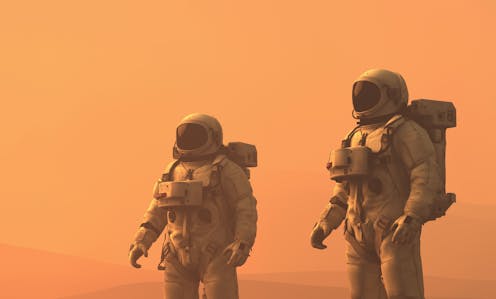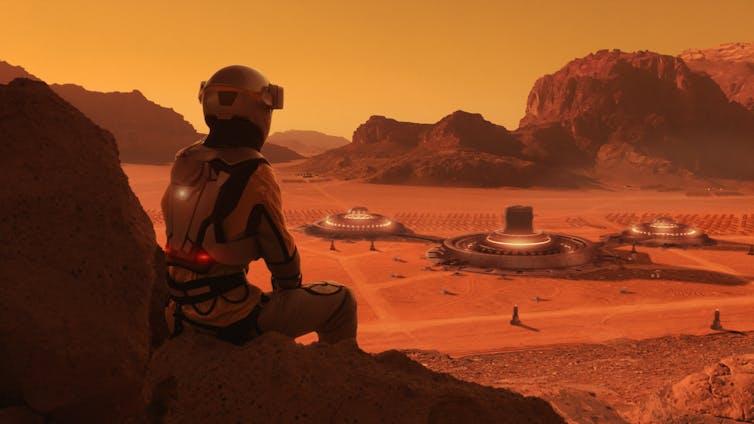What happens if someone dies in space?
If an astronaut were to die on Mars, neither cremation nor burial would be good options.


Curious Kids is a series for children of all ages. If you have a question you’d like an expert to answer, send it to curiouskidsus@theconversation.com.
What happens if someone dies in space? – Guillermo, Palm Beach, Florida
There’s no question that sending human beings to space is an extraordinarily difficult and perilous proposition.
Since human space exploration began just over 60 years ago, 20 people have died – 14 in the NASA space shuttle tragedies of 1986 and 2003, three cosmonauts during the 1971 Soyuz 11 mission, and three astronauts in the Apollo 1 launch pad fire in 1967.
Given how complicated human spaceflight is, it’s actually remarkable how few people have lost their lives so far. But NASA plans to send a crew to the Moon in 2025 and astronauts to Mars in the next decade. Commercial spaceflight is becoming routine. As space travel becomes more common, so does the possibility that someone might die along the way.
It brings to mind a gloomy but necessary question to ask: If someone dies in space – what happens to the body?

Death on the Moon and Mars
As a space medical doctor who works to find new ways to keep astronauts healthy, I and my team at the Translational Research Institute for Space Health want to make sure space explorers are as healthy as they can be for space missions.
Here is how death in space would be handled today: If someone died on a low-Earth-orbit mission – such as aboard the International Space Station – the crew could return the body to Earth in a capsule within a matter of hours.
If it happened on the Moon, the crew could return home with the body in just a few days. NASA already has detailed protocols in place for such events.
Because of that quick return, it’s likely that preservation of the body would not be NASA’s major concern; instead, the No. 1 priority would be making sure the remaining crew returns safely to Earth.
Things would be different if an astronaut died during the 300 million-mile trip to Mars.
In that scenario, the crew probably wouldn’t be able to turn around and go back. Instead, the body would likely return to Earth along with the crew at the end of the mission, which would be a couple of years later.
In the meantime, the crew would presumably preserve the body in a separate chamber or specialized body bag. The steady temperature and humidity inside the space vehicle would theoretically help preserve the body.
But all those scenarios would apply only if someone died in a pressurized environment, like a space station or a spacecraft.
What would happen if someone stepped outside into space without the protection of a spacesuit?
The astronaut would die almost instantly. The loss of pressure and the exposure to the vacuum of space would make it impossible for the astronaut to breathe, and blood and other body fluids would boil.
What would happen if an astronaut stepped out onto the Moon or Mars without a spacesuit?
The Moon has nearly no atmosphere – a very tiny amount. Mars has a very thin atmosphere, and almost no oxygen. So the result would be about the same as exposure to open space: suffocation and boiling blood.
What about burial?
Suppose the astronaut died after landing, while on the surface of Mars.
Cremation isn’t desirable; it requires too much energy that the surviving crew needs for other purposes. And burial isn’t a good idea, either. Bacteria and other organisms from the body could contaminate the Martian surface. Instead, the crew would likely preserve the body in a specialized body bag until it could be returned to Earth.
There are still many unknowns about how explorers would deal with a death. It’s not just the question of what to do with the body. Helping the crew deal with the loss, and helping the grieving families back on Earth, are just as important as handling the remains of the person who died. But to truly colonize other worlds – whether the Moon, Mars or a planet outside our solar system – this grim scenario will require planning and protocols.
Hello, curious kids! Do you have a question you’d like an expert to answer? Ask an adult to send your question to CuriousKidsUS@theconversation.com. Please tell us your name, age and the city where you live.
And since curiosity has no age limit – adults, let us know what you’re wondering, too. We won’t be able to answer every question, but we will do our best.
Emmanuel Urquieta is supported by the Translational Research Institute for Space Health.
Read These Next
As DOJ begins to release Epstein files, his many victims deserve more attention than the powerful me
Powerful men connected to Jeffrey Epstein are named, dissected and speculated about. The survivors,…
How to reduce gift-giving stress with your kids – a child psychologist’s tips for making magic and a
Depending on family circumstances and a child’s personality type, gift giving runs the gamut of fun…
The world risks forgetting one of humanity’s greatest triumphs as polio nears global eradication − 7
Polio may finally be defeated in the next 5 years. Will the world recognize what an extraordinary achievement…






